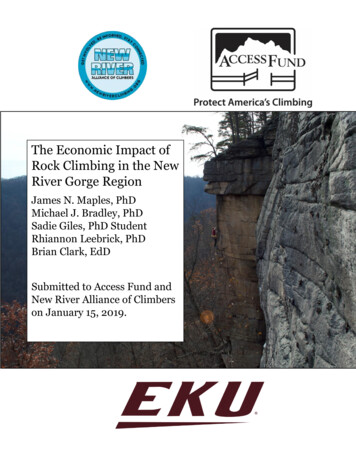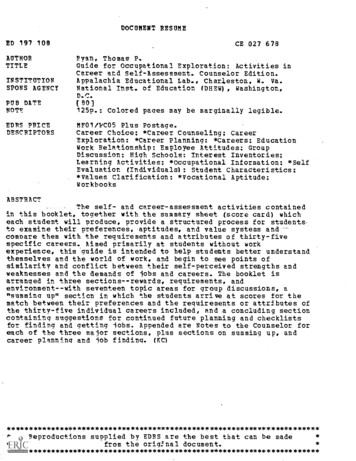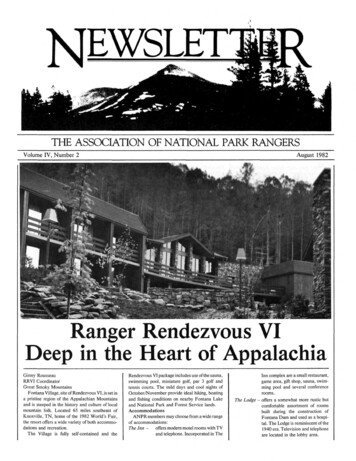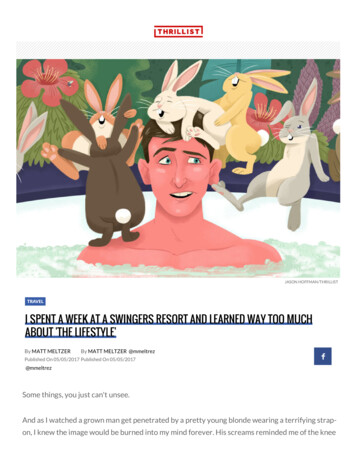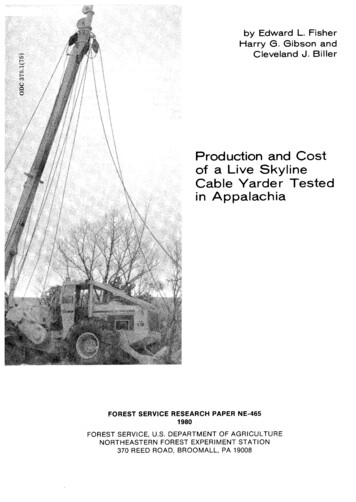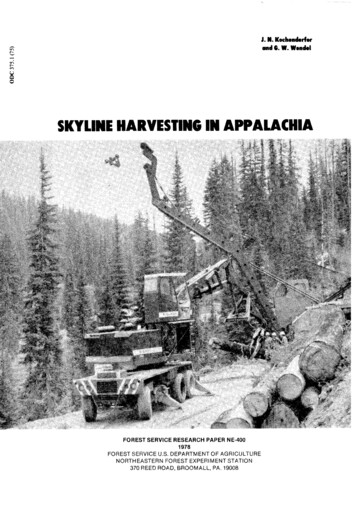
Transcription
SKYLIWE HARVESTIWG I W APPALACHIAFOREST SERVICE RESEARCH PAPER NE-4001978FOREST SERVICE U.S. DEPARTMENT OF AGRICULTURENORTHEASTERN FOREST EXPERIMENT STATION370 REED ROAD, BROOMALL, PA. 19008
--AbstractThe URUS, a small standing skyline system, was tested in the AppalachianMountains of north-central West Virginia. Some problems encountered withthis small, mobile system are discussed. From the results of this test andobservation of skyline systems used in the western United States, the authorssuggest some machine characteristics that would be desirable for use in theAppalachians.The AuthorsJ. N. KOCHENDERFER has been employed by the Forest Service since 1960and since 1967 has worked for the Northeastern Forest Experiment Station'sfield laboratory at Parsons, West Virginia. He received his bachelor ofscience degree in forestry from West Virginia University and his master'sdegree in forestry from Duke University. His major work was in tirnbermanagement before he went into forest hydrology research.G. W. WENDEL is a research forester for the Northeastern Forest Experiment Station, stationed at the Timber and Watershed Laboratory, Parsons,West Virginia since 1962. He received a B. S. in Forestry from Iowa StateUniversity in June 1951, and an M. F. from Yale University School ofForestry in June 1957.Before joining the Northeastern Forest Experiment Station, he worked 5years with the Southeastern Forest Experiment Station, and 3 years with theSoutheastern Forest Experiment Station, and 3 years with the New JerseyDepartment of Conservation and Economic Development.MANUSCRIPT RECEIVED FOR PUBLICATION 11 JULY 1977
I N T H E Appalachian mountains, most timber isharveslted by ground skidding systems. Wheeledskidders are the most widely used machines. Amajor criticism of skidder operations is the denseroad network required to move the logs to landings, O f t e n these road systems are poorly planned,d o not protect other resources, and are estheticallyunpleasant when viewed in the landscape.For example, Kochenderfer (1977) measuredbulldozed roads on nine skidder- and two jammerlogged jobs in north-central West Virginia. Onskidder jobs, road spacing seldom exceeded 150feet, with one mile of road required to log about20 acres. On the jammer jobs, where a truck cranewas used to yard and load logs, road spacing averaged about 250 feet; here, 1 mile of bulldozedroad was needed to log about 31 acres. With astanding skyline cable system, we were able to logabout 8 0 acres from 1 mile of road.Figure 1.-TheOn the Fernow Experimental Forest near Parsons, West Virginia, we tested a standing skylinecable system-hat might have application in thecentral Appalachian mountains. The Forest Engineering Project of the Northeastern ForestExperiment Station from Morgantown, West Virginia, cooperated in these tests.The machine was a URUS,2a small mobile unitmade in Austria with a skyline capacity of 1,100feet of '/,-inch cable (Fig. 1). The unit has a 28foot tower and a carriage that automaticallyclamps onto the skyline when stopped. The corri' For definitions of cable logging terms, refer to the glossaryat the end of this paper.T h e use of trade, firm, or corporation names in thispublication is for the information and convenience of thereader. Such use does not constitute an official endorsement orapproval by the U.S. Department of Agriculture or the ForestService of any product or service to the exclusion of others thatmay be suitable.URUS, the skyline system used in these tests.
dors ranged from 600 to 900 feet long and averaged 789 feet. Spacing between corridors averaged150 feet. Since the URUS had previously beenused almost exclusively in clearcutting, weconfined our tests t o partial cutting. Averagelateral yarding distance under these conditionswas 75 feet on either side of the skyline.We also observed cable systems, including liveand running skylines, currently used in the easternand western United States. Although we recognizethat skyline cable systems differ in mechanics andcomplexity (Studier and Binkley 1974), all can beused in clearcutting and in partial cutting.M W P YTopography is extremely important in determining the utility of any skyline system becauseregardless of the system used, there must be adequate clearance between the ground and skyline.In mountain country, skylines operate best onconcave slopes, with all logs yarded across the hollows. However, there is a great diversity of topography in the central Appalachians and frequentlyconcave and convex slopes are mixed with smallbenches and frequent rock outcrops (Fig. 2). Withskyline spans of 800 to 900 feet, the URUS neededat least one, and frequently two, intermediate supports to elevate the skyline so that the front endsof logs would pass over obstructions. Slope is important in gravity-feed systems, especially whensmall and relatively light carriages are used. Thecarriage must gain sufficient momentum to unspool and drag several hundred feet of mainlinecable. In the West, slopes must be greater than 25percent for these systems to operate efficiently.On lesser slopes and in downhill yarding, powermust be used to pull out the carriage and pull slackfor lateral yarding.Unfavorable topography can be overcome tosome extent by building roads in the most favorable locations possible. Other measures to counteract it are (1) shortening the skyline span, (2)elevating the skyline block or anchor, (3) increasing the height of the tower, and (4) using intermediate supports. For example, we used a 28-foottower to log 39 corridors with the skyline blockelevated to 30 feet and an average skyline length of789 feet. Two supports were required on 15 ofthese corridors, 17 required 1 support, and 7 required no supports. The results of an analysis ofthe same ground profile data showed that with a40-foot tower on the URUS, 11 corridors couldhave been logged without supports. By shorteningthe skyline to 500 feet and using a 28-foot tower,55 percent or 21 of the corridors probably couldhave been logged without intermediate supports.By raising tower height to 40 feet and holdingspans to 500 feet, we could have logged 85 percentor 33 of the corridors without supports. Theslopes we logged averaged 46 percent and wererelatively constant convex slopes with numerousrock outcrops up to 15 feet high. As previouslypointed out, slopes like these are the least desirable for cable logging. We believe that many spanslonger than 500 feet cannot be logged without intermediate supports in the central Appalachiansbecause of topographic restrictions.Cable logging should not necessarily be restricted to steep land. Many of the skyline systemsthat we observed had the capability of loggingrelatively gentle topography. The use of cable systems on gentle slopes (e.g. 30 percent) would eliminate about as many roads as on steep slopes (e.g.50 percent) because road density is controlled byfactors other than steepness. Logging met hods,topography, and obstacles such as cliffs, streams,and property lines influence road density. In general the less steep areas in the eastern mountainsare often the best timber growing sites. Skylinelogging would require a lower road density anddamage t o the site from compaction would beminimized.Much of the timber that is logged in the centralAppalachians consists of low volume and valuestands on steep, less accessible land. The questionthat has to be asked: Can this timber be loggedwith equipment that is often more expensive t ooperate than conventional ground skidding systems?Topography is also important after t h e logshave been yarded to the spar. If the yarder is on aridge top, logs can usually be dropped withoutsliding downhill, and they can be moved from beneath the skyline with a tractor or skidder. Onmidslope roads in steep country, there is usuallyinsufficient decking space in front of the yarderand logs tend t o slide down the slope. Where fixedtowers are used, logs must be held by the yarderuntil they are secured by a cable from a tractor orskidder. In the West, hydraulic grapple loaders areused to remove logs from in front of the yarder.However, if yarders are equipped with swingingbooms, logs can be swung and decked parallel tothe road or on the road.
Figure 2.-Typesof skyline situations.CONCAVE SLOPE.CONCAVESLOPE
Skyline PlanningPlanning is an integral part of any logging job,regardless of the system used, but our experienceand that of others has shown that cable systemsdemand more thorough planning than others(Burke 1975, Studier and Binkley 1974, Lysonsand Wellburn 1976). The first step is to obtain thebest topographic maps and aerial photographsavailable. From these, an access system and arough logging show can be outlined. In the easternUnited States, the U. S. Geological Survey 7Mminute quadrangle sheets which have a contour interval of 20 or 40 feet are readily available. Although they show none of the small obstructionssuch as rock outcrops and small benches, they aresufficiently detailed for determining road locations, landings, rough ground profiles, and corridor locations. The area should then be reconnoitered and roads, landings, and corridor locations flagged out.Besides the topographic and environmental considerations, timber volume and value per acre arevery important. The cut per acre must be carefullyconsidered because it is probably the single mostimportant variable that affects yarding costs.Most experience indicates that skyline logging, atleast in partial cuts, is more expensive than conventional ground skidding (Aulerich and others1974).In the eastern United States, ownerships arerelatively small and access to a given tract of timber is often controlled by property lines andtopography. These characteristics of the tract tobe logged must be considered when selecting themachine for the job. Mobility, rapidity of setupand tear-down, and ability to work from narrowroads are important factors to consider on smalltracts.Corridor locationFrom the planning map and reconnaissance ofthe area, we can determine the number, length,and direction of corridors needed to harvest thevarious parts of the sale area.Because topography changes over relativelyshort distances in the Appalachian mountains, webelieve that most corridors longer than 400 or 500feet will have to be laid out on the ground beforelogging when partial cutting is used. Mixtures ofconvex and concave slopes, frequent rock outcrops, and dense vegetation all limit visibility,which makes "eyeballing" corridor center linesdifficult or impossible for long distances. In clearcuts, where preliminary information indicates thatintermediate supports are not required, it seldomis necessary to mark corridor locations on theground. Suitable tail trees are usually visiblearound the perimeter of the clearcut where thereare no standing trees to interfere with passage ofthe carriage or tensioning of the skyline.We have found that ground profiles of corridors can be made with a staff compass, 100-foottape, and a surveying altimeter. An Abney level orclinometer can also be used to determine differences in elevation along the corridor. Fieldwork is best done in the fall and winter when hardwoods have shed their leaves.Suitable tail trees will seldom be found in linewith the initial corridor centerline. If referencestations have been established on the original line,adjustments to the true line can be made by simpleoffset procedures. When adjustment of theoriginal line is not necessary, the tail tree o n thenext corridor can be selected and the corridorcenterline can be staked out going uphill. Frequently, however, rock outcrops or poor machinesites will require that this line also be adjusted. Tocomplete the job, a stake is set to mark the location of the tower, the corridor centerline isflagged, and the tail tree and skyline afichor treesare flagged. When guylines are needed on the tailtree, guy trees are also flagged.From the field survey notes the loaded skylineprofile can be plotted over the ground profile byone of the available computer programs (Carsonand others 1971). This plotting will indicatewhether topography is a problem by showing thecritical points along the loaded line, and whereand how much the skyline must be elevated forlogs to clear ground obstructions adequately (Fig.3). If problems appear, the options previouslymentioned can be used to overcome them.In partially-cut stands, we observed that yarding hangups were less frequent when corridorswere oriented at right angles to the contour. Atless than right angles, logs on the uphill side o f theskyline tend to roll behind trees and rocks whenbeing yarded to the skyline. In clearcut areas,orientation of skyline corridors is less critical,
Figure 3.-Typical skyline profile on a relatively uniform slope.URUS MOBILEYARDERLOADED SKY LINE CABLE WITHOUT SUPPORTLOADED SKYLINE CABLE SUPPORTEDTREE0100200300400500600700800DISTANCE (FEET)Intermediate SupportsAlthough our tests with the URUS were not designed to study intermediate supports per se, weused them frequently and have a good idea ofwhat they involve.Intermediate supports add to the work of planning, laying out, and rigging for a skyline operation. The added work is about the same in clearcuts as in partial cuts, In both, corridor locationsmust be selected and support trees designated before cutting, because suitable support trees at thecritical deflection points might otherwise be cut.When choice must be made, it is better to locatetrees uphill from critical points. In rigging supporttrees, the blocks are normally hung about 25 to 30feet high to obtain a clearance of 4 to 6 feetbetween the skyline and the ground when the skyline is loaded to capacity.Only skyline systems that can be rigged asstanding or fixed skylines can be used with intermediate supports. To our knowledge, supportshave not been used with running skylines.In planning a skyline cable operation where to-pography presents serious deflection problems, wehave to consider whether the increase in skylinelength obtainable by using intermediate supportscan be justified. The major disadvantage ofshortening corridor length, from 800 feet to 500feet, is the increase in road density required to loga given area, It also reduces by about one-third thearea logged per corridor. Where deflection permits longer spans to be efficiently logged withoutintermediate supports, costs can be spreadadvantageously over larger volumes. For example,the additional time needed to pull out an additional 500 feet of skyline is small compared tothe increase in volume that might be obtained. Ifincreasing span length means using one or moreintermediate supports, then the additional workrequired to set them must be carefully evaluated,In addition to rigging time, the time in planning,skyline layout, location of critical points, andselection and designation of support trees must beincluded. Where environmental constraintsseverely limit road construction, long multispanskylines may be the only way timber can be harvested .
Timber FellingTimber felling is most important for efficientskyline logging in partial cuts, less critical in clearcuts. Trees felled haphazardly or crisscrossed willhang up and slow the yarding operation when theyare pulled toward the skyline. Whenever possible,trees should be felled downhill, at an angle of 25or 30 degrees from the skyline corridor. Thisherringbone pattern is particularly important inpartial cuts. In this position, logs are pulled moreeasily toward the skyline, with less side-strain onthe system than if they are at greater angles.Usually, the higher the skyline (i.e, the greater theclearance between ground and skyline), the lesscritical timber felling becomes. With a high skyline, the hooked end of the log is raised above theground sooner in lateral yarding, and the likelihood of its hanging up is reduced.eludes a block in each of two trees (one on eachside of the skyline), guying these trees, hoisting theintermediate supports with a portable winch, andtying-off the support cable (Fig. 3). Intermediatesupports should hold the skyline at least 15 feetabove the ground.Another problem in rigging is to find suitabletail and support trees; usually over 14 inches dbh,well-anchored, and with no visible rot in the stemor upper bole. They must have 20 to 30 feet ofclear stem and be climbable with tree spurs or aladder. Ideally, intermediate support trees shouldbe 20 to 30 feet apart, and on about the same contour level. Guy trees can be somewhat smaller,probably not less than 12 inches at the stump,where most guylines will be tied off. Otherwise,these trees should possess the same characteristicsas tail and support trees.In the URUS tests, we hung the tail block about30 feet above the ground. Tree climbing laddersworked best for our crew but we see no reasonwhy climbing spurs cannot be used. Ladders arecumbersome to move from one corridor toanother, especially across cut-over areas.Cable logging requires a high degree of practicalengineering know-how and skill; people with thisability are needed to make systems such as theURUS workable. Shorter skyline spans (500 feetmaximum) and machines with spars of 40 feet ormore can simplify the rigging job by eliminatingintermediate supports. Also, cable logging probably is more strenuous than conventional loggingbecause heavy loads often must be carried downsteep slopes for 600 t o 800 feet. There is no denseroad system, as there is in conventional logging, towalk or drive on. Rigging would be easier if roadswere spaced to give access to taitrees or perhapseven allow the use of mobile tail spars.In skyline logging where partial cutting is used,choker setting is probably the most important job.The choker setter must stop the carriage at a pointon the skyline where logs hooked to it can moveunobstructed toward the skyline, and cause aminimum of residual stand damage and sitedisturbance. Good communication must bemaintained between the choker setters and yarderoperator. After some experimentation, we foundthat portable remote control systems such as theTalkie-Tooter2worked well.At first we used conventional cable chokers, butoften they were too long and the front end of thelog was not lifted above the ground. Then we triedchokers of various sizes, taking a couple of hitchesaround small logs, but it was always a problem tofree the logs from obstacles and unhook. Wefinally settled on chain chokers which enabled usSonn Thoughts on a Skylineto hook the mainline within 3 or 4 inches of theSysktn for th.Eastlog. These worked well except that yarding wasusually limited to one log. Where Clearance beTwo yearsy experience with the URUS and obt w e e n t h e s k l i n e a n d g r o u n d i s a r o b l e m2 ,o r 3 servation of other cable systems in theeasternandfeet of lift on the front end of the log Can western United States provides us some insight aseliminate many hangups during yarding.to the kind of machine best suited for the Appalachian mountains. Because eastern ownershipsSkyliw Riggingare small, and rights-of-way are often difficult toRigging a standing skyline such as the URUS obtain, the machine should be highly mobile andconsists of guying the tower, hanging a block in able to negotiate steep, narrow roads (12 to 14 feetthe tailtree, guying the tailtree (if necessary), and wide). If the machine is mounted on rubber tirestying the skyline to an anchor tree or stump. If rather than tracks, short moves over public roadsintermediate supports are required, the rigging in- can be made without loading it on a lowboy.
The size of the machine is another importantconsideration. Many bridges in the East haveweight limitations, so the machine weight shouldnot exceed 70,000 pounds. The cost of a machine,of course, varies with its size, but we believe thatthe cost will have t o be less than 100,000 if theaverage eastern contract logger is expected topurchase one.The machine should have a swinging boom sothat logs can be decked parallel to the road ordropped in the road behind the yarder. This issafer for the crew and logs can be cold-decked, ifnecessary.Since setup and tear-down times are importantcomponents of cost, we believe the machineshould be equipped with hydraulic guylinewinches and hydraulic outriggers for leveling. Inaddition, the machine should have a mainlinespeed of 1,000 feet per minute and be operablewith four men or less.In the West, the least volume removed in thin-Figure 4.-Anings was about 6 M bmlacre. The stumpagevalue of this material is similar to our hardwoodvalues, Most eastern hardwood stands are harvested using some partial cutting system, andusually they will only support a cut of about 4 to 6M bmlacre every 20 t o 30 years. If skyline cablelogging is feasible under these conditions, we feelthat some of the machines used in the West forthinning (Fig. 4) might be of suitable size and costfor logging in the East.The machines used for thinning small material(10 to 20 inches dbh) in the West are much largerthan we had envisioned. Even though mostmaterial logged in the East is in this size range,hardwoods weigh about one-third more per cubicfoot than western conifers. We feel that a machineshould be rugged and capable of yarding a 10,000pound load. Failures in our system always occurred when hangups caused maximum loads onthe system.In our opinion, a running or live skyline systemconverted shsvel at work in the western United States.
would best suit our needs-a machine capable oflowering or raising the skyline at will. These systems permit the use of simple, more rugged carriages. Carriages that lock automatically requiremore care and adjustment, and are less able t owithstand day-to-day hard use. Simple, ruggedslack-pulling carriages that can yard logs laterallyfrom 100 feet on either side of the skyline arenecessary for partial cutting. Running skyline systems usually have slack-pulling devices; thesimpler systems, such as the live or shotgun,employ simpler carriages with manual slack pulling. Running skylines are the most versatile systems known today (Lysons and Twito 1973; Burke1975), but we feel that cost of the available ones isprohibitive for most eastern operations.The equipment should have the capability toyard from distances of at least 1,000 feet. Eventhough we visualize most spans in the 400- to 600foot range, there are situations, such as across hollows or concave slopes, where the longer capability would be desirable.Another feature to consider is the equipment'sability to log downhill. Theoretically, if you couldlog 500 feet uphill and 500 feet downhill, roadscould be spaced 1,000 feet apart, However, downhill yarding has not gained wide acceptance. Mostexperienced loggers feel that its problems (forexample, controlling the turn of logs and keepingthem from rolling behind trees) were too great toovercome. It would be dangerous and impracticalon midslope roads because it would require yarding over cut banks, and logs would be likely toroll. A running skyline system is probably best fordownhill yarding, but yarders that have this capability are more complex and costly than systemsthat use gravity-powered carriages.In summary, the combinations of timbervolume and value in the East probably will notsupport the more sophisticated yarding systemsused in the West. Until more suitable equipment isdeveloped, a live skyline system with skyline andmainline drums and a gravity carriage seems mostacceptable. It should be highly mobile and capableof yarding up to 1,000 feet. It should have a mainline speed of about 1,000 feet per minute andshould be operable by a 4-man crew. It shouldhave hydraulic guy winches, hydraulic outriggersfor leveling, and a 40- to 45-foot ""swing boom''tower. Even with these desirable features, it remains to be proven that skyline systems are aneconomically viable alternative to existing groundskidding systems in the East.(Cable LqgingrCarriage.-A wheeled device that rides back and forthon the skyline for yarding or loading.Choker.-A noose of wire rope or chain for hauling alog.Cold-deck.--An area where yarded or skidded logs arestored prior to hauling to the mill.Corridor.-Thepath cleared to allow passage of thecarriage and logs when yarding in partial cuts or thinning .Corridor length.-Thecleared corridor distance between the tower and tailtree or skyline anchor.Deflection.-The vertical distance between the chordand the skyline, measured at midspan-frequently expressed as a percentage of the horizontal span length.Gravity feed.-Skyline system which depends on gravity to pull the carriage down the skyline.Ground skidding.-Movementof the log from thestump to landing with a wheeled or tracked machine.Guy.-A rope, chain, or rod attached to something tobrace, steady, or guide it.Guy tree. -A tree used to anchor a guy.High-lead.-Acable logging system in which leadblocks are hung on a spar to provide lift to the frontend of the logs.Intermediate support or skyline jack.-Adevice thatsupports the skyline at an intermediate point.Intermediate support tree.-Tree(s) located between thetower and tailtree to support an intermediate supportor skyline jack.Jammer.-Alight weight, two-drum yarder , usuallymounted on a truck with a spar or boom-may beused for both yarding and loading.Live skyline.-A standing skyline that can be raised andlowered during yarding.Main line.-The hauling cable.Multispan skyline.-A skyline having one o r moreintermediate supports.Rigging.-Thecables, blocks, and other equipmentused in yarding logs.Running skyline.-A system of two or more suspendedmoving lines, generally referred to as main and haulback, that when properly tensioned will provide liftand travel to the load carrier.Skyline.-Acableway stretched tautly between twospars and used as a track for log carriers.Skyline anchor.-Usually a tree or stump located behind the tailtree, when one is used to anchor the skyline.' Adapted from Glossary of cable logg ngterms, U . S . Dept,Agric. For. Serv. Pac. Northwest, For. Range Exp. Stn. PortIand, Ore. (19691, and Cable logging systems (Studier andBinkley 19'74).
Skyline block.--A block on the tailtree that the skylineLiterature Citedruns through.Skyline length.-Theamount of line suspended be- Aulerich, D. Edward, K. Norman Johnson, and Henry Froehlich.tween the headspar and skyline anchor.1974. Tractors or skylines: What's best for thinning youngSkyline logging.-A logging method in which a blockgrowth Douglas fir? For. Ind. 101(12):42-45.or carriage rides on a skyline.Doyle.Span.-Thehorizontal distance between the headspar Burke,1975. Running skylines reduce access road needs, minimizeor anchor point, and the tail spar or ancttor point.harvest site impact. For. Ind. 102(1):46-48.Spar.-The tree or mast on which rigging is hung for Carson, Ward W., Donald Studier, and Hilton Lyons.1971. Running skyline design with a desk-top counter plotone of the many cable hauling systems.ter. U.S. Dept. Agric. For. Serv. Res. Note PNW-153, 21 p.Standing skyline.-A skyline anchored at both ends.Kochenderfer, James N.Straw line.-A light cable used to string heavier lines.1977. Area in skidroads, truck roads and landings after logStraw drum.-A small drum on yarders; handles theging in the central Appalachians. J. For. 75(8):507-508.straw line.Lysons, Hilton H. and Roger H. Twito.Tai1tree.A spar at the outer end of the skyline logging1973. Skyline logging: An economical means of reducingoperation, away from the landing.environmental impact of logging. J. For. 71(9):580-583.Tower.-Asteel spar attached to the yarder used to Lysons, Hilton H. and G . Vernon Wellburn.1976. Planning mountain logging on the American Westsupport the skyline and other rigging.Coast. IUFRO World Congr. Proc. Norway 1976. p. 100Yarder .-A system of power-operated winches used to117.haul logs from a stump to a landing.Studier, Donald D. and Virgil W. Binkley.Yarding.-The act or process of conveying logs to a1974. Cable logging systems. U.S. Dept. Agric. For. Serv.Region 6, Div. Timber Manage. Portland, Ore. 21 1 p.landing. In our opinion, it is more consistent with accepted terminology to restrict the term "yarding" tothe conveying of logs with cable systerns. "Skidding"refers to dragging logs behind animals or machinestraveling on the ground.
that skyline cable systems differ in mechanics and complexity (Studier and Binkley 1974), all can be used in clearcutting and in partial cutting. MW P Y Topography is extremely important in deter- mining the utility of any skyline system because regardless of the system used, there must be ade- quate clearance between the ground and skyline.

